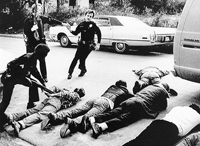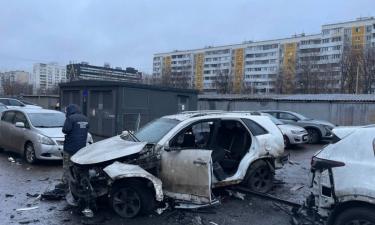Greensboro Massacre: Justice Delayed or Denied?
One fundamental right Americans enjoy is the right to be free from “double jeopardy.” As described in the Fifth Amendment to the Bill of Rights, double jeopardy means that no person shall “for the same offense . . . be twice put in jeopardy of life or limb.” Court rulings dealing with double jeopardy issues ultimately developed the “merger doctrine.” This doctrine has two prongs.

One prong states that when a person is found guilty of a criminal offense all lesser offenses that were—or that could have been—charged “merge” into the most serious offense. This means that a person guilty of murder (a greater offense) cannot also be punished for manslaughter (a lesser offense) if both charges resulted from the same set of facts. However, if a person is acquitted of the greater offense, he can still be found guilty of the lesser, since the elements required to prove manslaughter are not as stringent as those required to prove murder.
The second prong states that if a person is found “not guilty” of the greater offense, a prosecutor cannot then “recharge” him with any lesser-included offense that emanates from the same set of circumstances. Therefore if a judge or jury is presented with only two options, murder or acquittal, and they choose acquittal, a prosecutor cannot subsequently charge a person with manslaughter if the charge is based upon the same set of facts.
These scenarios often create strategic dilemmas for both prosecutors and defense attorneys. Prosecutors may want to forego a lesser-included option if this option might result in the defendant receiving less punishment than they believe is warranted. But failure to add lesser-includeds also enhances the risk that a guilty defendant may avoid criminal punishment altogether.
Defense attorneys, on the other hand, may want to exclude a lesser-included option, because it gives juries the capacity to create “compromise” verdicts. Not wanting to convict on the more serious charge, but not wanting to acquit a defendant outright, a jury may settle on the lesser-included charge—a victory for defense attorneys if their clients are guilty, but a miscarriage of justice if their clients are innocent.
Still, in spite of the “merger doctrine,” courts have found ways around the prohibition against double jeopardy.
One such way is the doctrine of different “sovereigns.” Sometimes a person not only violates the laws of a particular state, but the laws of the federal government as well; consequently an individual found “not guilty” in a state court can still be prosecuted in a federal court for the same acts or omissions.
Another route around double jeopardy resides in the differing burdens of proof between criminal and civil law. Under criminal law an accused has to be found guilty “beyond a reasonable doubt.” Under civil law, however, the burden, in most jurisdictions, is a “preponderance of the evidence,” which is much easier to meet. Thus a person found not guilty in a criminal court can still be ordered to pay monetary damages in a civil court. This is why, even after they were acquitted in criminal trials, O.J. Simpson and Robert Blake were still found civilly “liable” for the deaths of their alleged victims.
From this free lesson in criminal law and procedure, we now arrive at the heart of this article. On November 3, 1979, in Greensboro, North Carolina, a series of tragic events transpired that would ultimately embrace all the nuances of double jeopardy law: The Greensboro Massacre.
On that fateful day, members of a group calling itself The Communist Workers Party—which had been advocating for better working conditions, particularly in the textile industry—were holding a “Death to the Klan” rally. Suddenly members of the very group they were protesting, along with several Neo-Nazi supporters, confronted the protesters. Gunfire erupted, resulting in the deaths of five anti-Klan protesters, and the wounding of ten more.
Several Klansmen and Neo-Nazis were prosecuted on state criminal charges, and acquitted. This prompted federal authorities to file criminal charges, with the same result. Eventually some of the Klansmen, as well as the City of Greensboro, were found civilly liable for causing the death of one of the protesters and ordered to pay monetary damages.
For several years The Greensboro Massacre stood as another grim chapter in the sordid legacy of injustices that America’s legal system—by apathy or complicity—has perpetrated against labor leaders, left-wing activists, and racial or ethnic minorities.
But a recent article in the [Greensboro] News & Record, (February 26, 2008), may finally provide the catalyst that will bring some semblance of justice to the victims of The Greensboro Massacre. As reported by the News-Record, three African-American ministers recently revealed that at least fifty boxes of police files pertaining to the events of November 3rd may have been destroyed, and that this destruction allegedly occurred around the same time a Truth and Reconciliation Commission was investigating the shootings.
Upon the release of its findings in 2006, this Commission determined that most of the blame for the events of November 3, 1979 resided not only with the shooters, but with the Greensboro Police Department as well, since it allegedlyfailed to protect the protesters, even when information provided by an informant indicated that Klansmen and Neo-Nazis were planning a confrontation.
Two others findings by this Commission, however, deserve greater scrutiny.
The first is the Commission’s determination that the anti-Klan protesters share some of the blame for the events of November 3rd. One must wonder how this “blame the victims” scenario would have been received if the protesters had been killed by foreign terrorists.
It is not difficult to imagine the outcry that would result if a report suggested that five American government officials killed by Al-Qaeda were partially to blame for their deaths because they vociferously denounced terrorism.
So why shouldn’t the same standards apply when dealing with domestic terrorism?
After all, what is terrorism but a cabal of people believing they have the right, through force or violence, to silence and murder those who disagree with or oppose them? And it should not be forgotten that law enforcement authorities, during the 1960s and 70s, did not hesitate to call left-wing groups, like The Black Panther Party and The Weather Underground, “domestic terrorists.”
Another finding of this Commission stated that the jurors who acquitted the Klansmen and Neo-Nazis in the state and federal trials were not representative of the community. Yet it appears to strain the boundaries of coincidence to presume that two separate juries would hear the same set of facts, reach the same result, and yet neither of them would be representative of the community. Unless, of course, they were not intended to be representative of the community in the first place.
During the 1960s, in an effort to stifle the momentum of the civil rights movement, many Southern States established “Sovereignty Commissions.” It was later revealed that these commissions often engaged in jury tampering, particularly in cases involving the murder of civil rights activists.
Given this history, one must also ask: If fifty boxes of documents were indeed destroyed, is it because they revealed that some of the jurors in both the federal and state cases were neither fair nor impartial?
Some may argue that any investigation into the alleged destruction of these documents, and the information they might have revealed, would be moot, because double jeopardy would still prohibit the Klansmen and Neo-Nazis from being retried for the Greensboro shootings.
But there is another exception to the double jeopardy doctrine: Aleman vs. Judges of the Circuit Court. In this case, an attorney for accused murderer Harry Aleman bribed a Cook County Circuit Court judge named Frank Wilson, so Wilson would acquit Aleman of murder. This defense attorney then requested a bench trial where Wilson proceeded to do just that.
After revelations about the bribe came to light, Wilson committed suicide, and Aleman was charged with the very same murder Wilson had acquitted him of committing.
Although Aleman’s attorney argued that double jeopardy precluded a second trial, the United States Supreme Court (in one of its rare moments of clarity) ruled that the bribe of Wilson meant that Aleman was never in jeopardy during the first trial—thus the double jeopardy doctrine did not apply.
This precedent means that if an investigation into The Greensboro Massacre reveals tampering or similar influences on jurors in either the state or federal trial, and if the alleged destruction of these documents was designed to conceal evidence of such tampering or influence, then double jeopardy does not preclude the original defendants from being tried again. In addition, such an investigation may also expose new crimes, such as conspiracy and/or obstruction of justice, and thus result in new prosecutions.
Therefore it is imperative that the United States Department of Justice, the Federal Bureau of Investigation, and all other relevant federal agencies investigate whether documents relating to The Greensboro Massacre were indeed destroyed and what those documents may have revealed. They should also investigate or reinvestigate all the persons directly or indirectly involved in, as well as the circumstances surrounding, the events of November 3, 1979—before, during, and particularly after the shootings occurred.
Justice demands nothing less.
David R. Hoffman, Legal Editor of Pravda.Ru
Subscribe to Pravda.Ru Telegram channel, Facebook, RSS!




